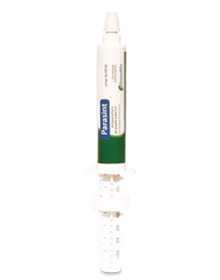Products — Parasint
Antiparasitics
Parasint
Ivermectin 1.2% + Praziquantel 15%
Benefits
- Broad spectrum of action: Ivermectin + Praziquantel.
- Controls with a single dose, the larval and adult forms of the main helminthes, tapeworms (cestodes) and Gasterophilus (oral and gastric stages).
- Provides maximum efficacy against tapeworms without doubling the dose, as in the case of Pyrantel Pamoate.
- Two presentations for 600 and 1,800 kg, allowing better adaptation to user needs.
- Excellent palatability and pasty consistency ensure better acceptance, facilitate treatment and avoid wasting the dose.
- Optimal tolerance, it can be administered safely: Mares in any state of pregnancy. Foals from 6 weeks of age. Stallions: does not interfere with spermatogenesis or reproductive behavior.
Description:
Oral broad spectrum antiparasitic.
Composition:
Each gram of product contains:
| Ivermectin | 12 mg |
| Praziquantel | 150 mg |
Indications:
Wide spectrum antiparasitic indicated for the treatment of parasitic diseases in horses caused by the following parasites:
Large Strongyles: Strongylus vulgaris (adults and arterial larvae). Strongylus edentatus (adults and cystic larvae). Strongylus equinus (adults). Tridontophorus spp. (Adults).
Other Nematodes: Parascaris equorum (3rd and 4th instar adults and larvae). Oxyuris equi (adults and 3rd and 4th instar larvae). Trichostrongylus axei (adults). Strongyloides westeri (adults) Draschia app. (3rd instar larvae). Habronema muscae (adults). Onchocerca spp. (microfilaria). Dictyocaulus arnfieldi (adults and 4th instar larvae).
Cestodes: Anoplocephala magna, Anoplocephala perfoliata. Paronaplocephala mamillana (adults and immature forms, scolex and body).
Larvae: Gasterophilus spp. (oral and gastric stages). Control of skin lesions caused by larvae of Habronema spp., Draschia spp. (summer sore) and skin microfilariae from Onchocerca spp..
Foals, stallions and pregnant mares can be treated safely in the indicated manner. It should be administered for the first time when foals are between 6 and 8 weeks old and then each time it is considered necessary according to the criteria of the acting professional.
Pregnant mares can be treated in any month of gestation, although it is advisable to do it 1 month before and 1 month after calving to reduce pasture contamination in spring and summer, thus reducing infestations in foals.
Therapeutic Action:
Ivermectin: It works by potentiating the neuronal inhibitory action of GABA on the ventral nervous system of nematodes. It prevents the transmission of the nervous stimulus causing flaccid paralysis of the parasites.
Praziquantel: Increases the flow of calcium through the parasite's integument causing its vacuolation and disintegration. It exposes parasitic antigens, activating the defense mechanisms of the host. It also alters the metabolism of cestodes, interfering with glucose uptake, lactate release, and glycogen and ATP levels.
Dosage and Administration:
1 g of Parasint Every 60/kg b.w. (equivalent to Ivermectin: 200 mcg/kg b.w. and Praziquantel 2.5 mg/kg b.w. Each mark on the plunger is equivalent to 1 g of product.
The product is administered orally, as follows: The plunger of the syringe is graduated according to the dose to be administered according to the weight of the horse. Each mark on the plunger is equivalent to 1 g of product, an amount indicated for 60 kg of animal weight. The syringe cannula is placed in the interdental space of the animal, verifying that it is free of food. The plunger is pressed so that the paste is deposited on the back of the tongue. The animal's head should be raised immediately for a few seconds to facilitate swallowing the medicine.
Species:
Horses.
